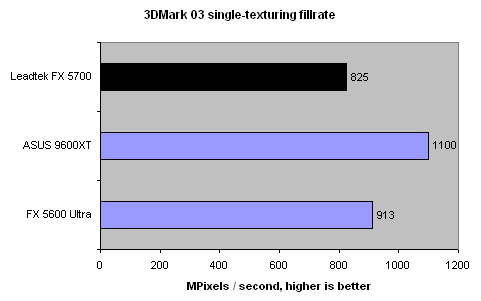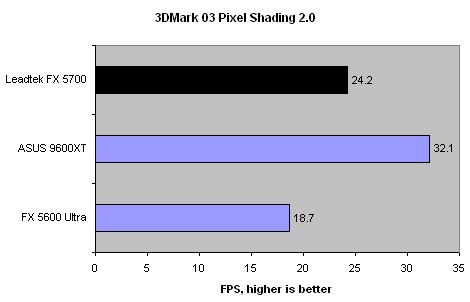Comparative specs. and shader performance
Before we begin formal benchmarking, we'd like to take this opportunity to discuss the card's technical merits and how it stands in relation to its competitors| ASUS Radeon 9600XT/TVD | NVIDIA GeForce FX 5600U | Leadtek A360TD FX 5700 | |
| GPU | RV360 | NV31 | NV36 |
| Transistor count | ~75m | ~80m | ~82m |
| Manufacturing process (micron) | 0.13 | 0.13 | 0.13 |
| Pixel pipelines | 4 | 4 | 4 |
| Memory bus width | 128-bit DDR | 128-bit DDR | 128-bit DDR |
| Texturing units per pipe | 1 | 1 | 1 |
| Core clock | 499MHz | 400MHz | 450MHz |
| Memory clock | 594MHz | 800MHz | 552MHz |
| Pixel fillrate | ~2000 Mpixels /sec. | 1600 Mpixels / sec. | 1800 Mpixels / sec. |
| Texture fillrate | 2000 Mpixels /sec. | 1600 Mpixels / sec. | 1800 Mpixels / sec. |
| Memory bandwidth | ~9.6GB/s | 12.8GB/s | ~8.8GB/s |
| RAMDACs | 2 x 400MHz | 2 x 400MHz | 2 x 400MHz |
| Estimated cost | £165 | £145 | £125 |
Given the FX 5600 Ultra's considerable bandwidth advantage, one might dismiss the Leadtek A360TD FX 5700 immediately. Our look at the FX 5700 Ultra reference board highlighted that the transition from FX 5600 - FX 5700 is more than just a slight makeover. The latter is subject to upgraded shading ability. NVIDIA reckons that the NV36 core has three times the vertex shading power of its predecessor, which will come in handy in DX9 games.
We'll have a look at the cards' performance in 3DMark03's features test. It should highlight some of the strengths or weaknesses of the NV36 design.

The Leadtek A360TD core has a potential single-texturing ability of 1800MPixels/s. We see it fall far short of its theoretical maximum here.

Its multi-texturing fillrate still falls some way short of theoretical and far, far short of the efficiency gained by the Radeon 9600XT.

Vertex shading, though, is much-improved from the NV31 design.

Pixel shading isn't too shabby. The Leadtek A360TD should do well in modern games that use copious amounts of shading as standard. Older games will probably run better on the high-bandwidth FX 5600 Ultra, courtesy of its 12.8GB/s of memory bandwidth. Let's put our assertions to the test.









